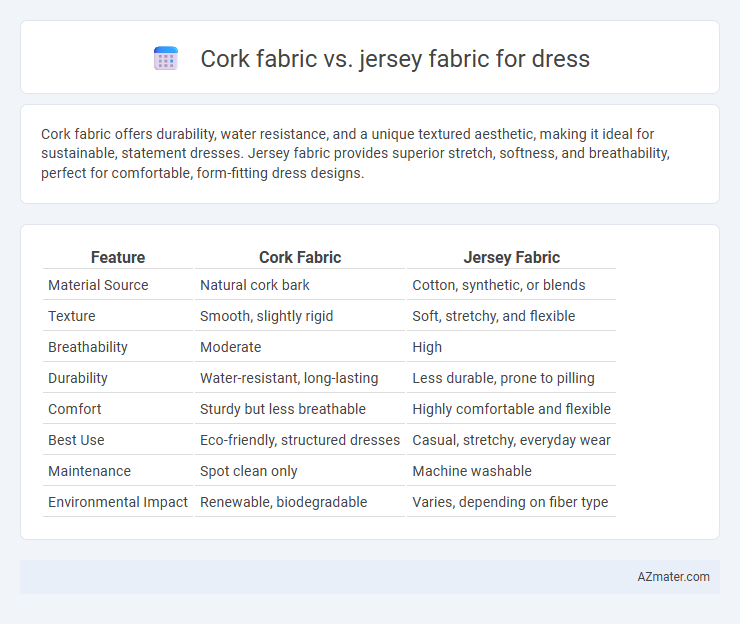Cork fabric offers durability, water resistance, and a unique textured aesthetic, making it ideal for sustainable, statement dresses. Jersey fabric provides superior stretch, softness, and breathability, perfect for comfortable, form-fitting dress designs.
Table of Comparison
| Feature | Cork Fabric | Jersey Fabric |
|---|---|---|
| Material Source | Natural cork bark | Cotton, synthetic, or blends |
| Texture | Smooth, slightly rigid | Soft, stretchy, and flexible |
| Breathability | Moderate | High |
| Durability | Water-resistant, long-lasting | Less durable, prone to pilling |
| Comfort | Sturdy but less breathable | Highly comfortable and flexible |
| Best Use | Eco-friendly, structured dresses | Casual, stretchy, everyday wear |
| Maintenance | Spot clean only | Machine washable |
| Environmental Impact | Renewable, biodegradable | Varies, depending on fiber type |
Introduction to Cork Fabric and Jersey Fabric
Cork fabric is a sustainable, eco-friendly material derived from the bark of cork oak trees, known for its lightweight, water-resistant, and durable properties--ideal for unique dress designs emphasizing texture and environmental consciousness. Jersey fabric, made from knitted cotton or synthetic fibers, offers exceptional stretch, softness, and breathability, making it a popular choice for comfortable, form-fitting dresses that drape well. Both fabrics serve distinct purposes in dressmaking, with cork fabric adding structural interest and sustainability, while jersey fabric prioritizes flexibility and ease of movement.
Key Differences in Material Composition
Cork fabric is made from the bark of cork oak trees, providing a natural, sustainable, and vegan-friendly material that is waterproof and durable. Jersey fabric, typically composed of cotton or synthetic fibers like polyester and spandex, offers a soft, stretchy, and breathable texture ideal for comfortable clothing. The key material difference lies in cork fabric's rigid, textured surface versus jersey fabric's lightweight, flexible knit structure, influencing dress design and wearability.
Texture and Feel: Cork vs Jersey Fabric
Cork fabric features a smooth, slightly textured surface that mimics natural cork bark, offering a firm yet flexible feel, ideal for structured dresses. Jersey fabric has a soft, stretchy, and breathable texture with a smooth finish, providing comfort and ease of movement suitable for casual and fitted dress styles. The choice between cork and jersey fabrics depends on desired dress aesthetics, with cork offering durability and unique texture, while jersey delivers softness and flexibility.
Durability and Longevity Comparison
Cork fabric, derived from natural cork bark, offers exceptional durability due to its resistance to wear, water, and tear, making it ideal for long-lasting dresses. Jersey fabric, typically made from cotton or synthetic blends, provides moderate durability with stretch and softness but tends to show signs of pilling and fabric thinning over time. Dresses crafted from cork fabric generally maintain their structural integrity and appearance much longer than those made from jersey, making cork a superior choice for longevity.
Breathability and Comfort for Dresses
Cork fabric offers moderate breathability with a natural, slightly rigid texture that provides structure but can feel less flexible compared to jersey fabric. Jersey fabric is known for its exceptional breathability and softness, making it highly comfortable and ideal for dresses that require stretch and movement. For dress materials, jersey fabric generally ensures superior comfort and ventilation, while cork fabric suits more structured designs with a unique aesthetic.
Eco-Friendliness and Sustainability
Cork fabric, derived from harvested cork oak bark, offers a biodegradable and renewable alternative to traditional textiles, making it highly eco-friendly for dressmaking. Jersey fabric, typically made from cotton or synthetic fibers, varies in sustainability depending on sourcing, but organic cotton jersey provides a breathable and biodegradable option with a lower environmental impact. Choosing cork fabric supports forest preservation and carbon sequestration, while organic jersey emphasizes sustainable agriculture and reduced chemical use.
Design Versatility and Style Options
Cork fabric offers unique design versatility with its natural texture and eco-friendly appeal, making it ideal for statement dresses and sustainable fashion collections. Jersey fabric provides unmatched stretch and drape, enhancing comfort and enabling a wide range of styles from casual to elegant silhouettes. Both fabrics support diverse design options, but cork is favored for structured, bold looks while jersey excels in fluid, form-fitting dresses.
Care, Maintenance, and Washing Tips
Cork fabric, made from natural cork bark, is water-resistant and durable, requiring gentle wiping with a damp cloth for cleaning rather than machine washing to maintain its texture and longevity. Jersey fabric, typically cotton or synthetic blend, is more delicate and benefits from cold machine washing on a gentle cycle to prevent stretching or pilling, with air drying recommended to preserve the fabric's softness and elasticity. Avoid bleach and high heat for both fabrics to ensure optimal dress care and extended wear life.
Cost and Accessibility Analysis
Cork fabric, sourced from sustainable cork oak bark, is significantly more expensive than jersey fabric due to its eco-friendly extraction process and limited production scale. Jersey fabric, made primarily from cotton or synthetic blends, is widely accessible and cost-effective, making it the preferred choice for mass-produced dresses. The cost difference is notable, with cork fabric dresses positioned as premium, while jersey offers versatility and affordability for everyday wear.
Best Use Cases: Choosing the Right Fabric for Your Dress
Cork fabric excels in eco-friendly, structured dresses that require durability and a unique textured appearance, making it ideal for statement pieces and sustainable fashion designs. Jersey fabric offers superior stretch, softness, and breathability, perfect for comfortable, casual dresses or form-fitting styles that demand flexibility and ease of movement. Selecting between cork and jersey depends on the dress's intended comfort, style, and environmental impact, with cork suited for bold, resilient garments and jersey favored for lightweight, everyday wear.

Infographic: Cork fabric vs Jersey fabric for Dress
 azmater.com
azmater.com